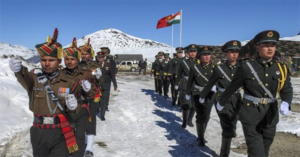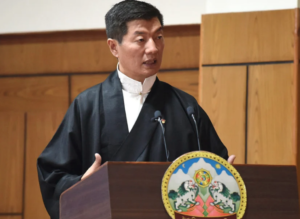The news of China’s most recent incursion into India, claiming some 60 square kilometres of Ladakh in the north of India, has led to speculation about China’s border policies and the implications for its neighbouring countries. A look at the history can provide an interpretation for China’s actions.
Until the collapse of the Qing dynasty in 1912, diplomatic activity in China was based on the “tributary system”. The Chinese people considered their emperor to be the “ruler of all under heaven” and this arrangement assumed that China was culturally and morally superior to all other nations. In practice this meant that those who wished to trade and deal with China were required to come as vassals to the emperor. The “tributary system” reached its fullest expression in Qing-Korean relations. Korean envoys would kowtow (complete prostration and knocking of the head on the ground) to the Qing Emperor and address him using terms appropriate when speaking to a superior. Similar relations existed between the Qing and all the nations on their eastern and southern border, including Tibet. The 13th Dalai Lama knelt before the Chinese Emperor when he visited Beijing in 1908, though His Holiness the 14th Dalai Lama claims that this act was simply one of deference to the Bodhisattva of Wisdom, who the Emperor was said to represent, and a purely spiritual, not political, act. European nations seeking trade at China’s ports also complied.
Qing rulers considered all the states in their local vicinity, including Thailand, North Vietnam, Mongolia and Tibet, to be part of their Empire. The rulers of these countries may have had other ideas, but they sent representatives to kowtow to the Qing Emperor because it seemed a small price to pay for the sake of trade relations with the rich Chinese. By the late 19th century, as Japan started to flex its military muscle and the French occupied Vietnam, the Qing claim to have “special rights” in the region as a result of these ancient tributary relationships was dismissed. The Qing lacked the military might to enforce their claims, and when the European concepts of sovereignty, suzerainty, spheres of influence and other diplomatic practices were introduced to Asia, China’s ancient claims were overwhelmed.
Fast forward to the present and there is media speculation that the People’s Republic of China is trying to reassert Chinese dominance in Asia. Tibet and East Turkestan [Ch:Xinjiang], the province in north west China, were forcibly incorporated into the modern Chinese Empire in the middle of the 20th century, and the recent events on the Sino-Indian border in Ladakh and, last year, at Doklam on the border with Butan, would suggest that China’s appetite for imperial expansion remains.

Representational image
According to reports in the Daily Telegraph and elsewhere, the Chinese People’s Liberation Army (PLA) have captured 60 square kilometres of Indian-patrolled land around the Pangong Tso Lake region in Ladakh since May. Matters came to a head on June 15, when up to 600 Chinese and Indian soldiers engaged in combat using stones, batons, iron rods and other makeshift weapons in the Galwan Valley region that straddles Ladakh and Tibet. The soldiers were not carrying firearms as a result of agreements disallowing their use at the Line of Actual Control (LAC) – the de facto border between the two countries since the late 1950s, and which China has never accepted. Twenty Indian soldiers from the 16th Bihar Regiment, including its commanding officer Colonel Santosh Babu, were killed in the skirmish. Unconfirmed Indian media reports suggested that there were also 43 Chinese casualties. The diplomatic fallout from the incident is ongoing and Indian and Chinese military officials are meeting regularly in an attempt to defuse tensions. Meanwhile, the Indian government has banned 59 Chinese phone apps, including the widely used WeChat and TikTok, from operating in India.
PLA officers have told their Indian counterparts that the events at Galwan were “an unfortunate incident” and sought to play down their significance. However, in recent weeks a substantial build up of Chinese troops along the LAC has taken place. As talks continued, China deployed two divisions of mechanised forces in the eastern Ladakh sector. Top Indian government sources also reported that the Chinese have readied another division of 10,000 soldiers in East Turkestan. These soldiers could be moved to positions on the LAC within 48 hours. To counter these activities, India has deployed two additional infantry divisions to the border and equipped them with extreme weather clothing, suggesting that they will be there for the long term.

CTA President, Dr Lobsang Sangyal
Sikyong Lobsang Sangay, president of the Central Tibetan Administration, has spoken on recent Chinese activities with reference to Mao Zedong’s “Five Fingers of Tibet”, “When Tibet was occupied, Mao Zedong and other Chinese leaders said, ‘Tibet is the palm which we must occupy, then we will go after the five fingers’. The first finger is Ladakh. The other four are Nepal, Bhutan, Sikkim and Arunachal Pradesh,” Sangay said in an interview with CNN-News18. He further warned India about the imperial ambitions of the Chinese: “Unless you know what happened in Tibet you will not fully understand the Chinese leadership mindset, their strategy. So, they have the palm, now they are coming after the five fingers… I am here condemning the violence and warning India and neighbouring countries that what happened to Tibet can happen to you.”
The Chinese government published a book for school students in 1954 entitled A Brief History of Modern China. This book featured a map showing territories allegedly taken from China by “imperialist powers” between 1840 and 1919. The map included Ladakh, Bhutan, Nepal, Sikkim, and the entire Northeast India and stated that these regions “must be reclaimed.” Scholars have concluded that this book was not mere propaganda, but a “serious reflection of Peking’s [Beijing] ambitions.” The recent events in the Galwan valley, combined with aggressive Chinese policy in Hong Kong, and Chinese support for Nepal’s territorial assertion in the Limpiyadhura-Kalapani-Lipulekh region on the border between Nepal and Uttarakhand in northern India, are being interpreted by some as part of a grander strategy by the Communist Party of China to fundamentally alter the geography of Asia and return China to the continental hegemony it enjoyed in the era of the Qing.




 Print
Print Email
Email